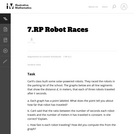
This task requires graphing time and distance.
- Subject:
- Mathematics
- Material Type:
- Activity/Lab
- Provider:
- Illustrative Mathematics
- Provider Set:
- Illustrative Mathematics
- Author:
- Illustrative Mathematics
- Date Added:
- 05/01/2012

This task requires graphing time and distance.
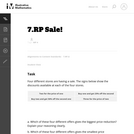
The purpose of this task is to engage students in Standard for Mathematical Practice 4, Model with mathematics and as such, the question as it is worded cannot be answered without making some assumptions. For example, if the items that are purchased do not have the same value, then the price reduction depends on the cost of the items.

A very short video introduction to how photosynthesis cycles energy through an ecosystem and a "real-world" application of ratios! Lindsay Hollister, JPPM's horticulturalist, taps a black walnut tree for its sap and park staff boil it down to create syrup. Included in this video are an animated food web showing the directions of energy flow during photosynthesis and when sap is "rising," which can be extended by students to include humans or more parts of their local ecosystem. Use the video as an introduction to activities about sugar and biological storage, and an excuse to sample maple syrup to taste the sugar. Alternatively, research trees nearby students could help tap and witness the biological transfer of energy themselves.
Always be sure you can successfully identify a plant before using it and take precautions to avoid negative reactions.
This resource is part of Jefferson Patterson Park and Museum’s open educational resources project to provide history, ecology, archaeology, and conservation resources related to our 560 acre public park. More of our content can be found here on OER Commons or from our website at jefpat.maryland.gov. JPPM is a part of the Maryland Historical Trust under the Maryland Department of Planning.

The goal of this task is to gather together knowledge and skills from the seventh grade in a context which prepares students for the important eighth grade notion of similarity.

Students will analyze ratios and use proportions to solve problems using a cooperative, kinesthetic activity in which they will create “human ratios.” Students will apply proportional reasoning to demonstrate application of a multiplicative situation by using cross products to solving proportions.
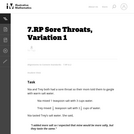
There is a non-mathematical fact that students must know about mixtures in order to answer this question. When salt is dissolved in water, the salt disperses evenly through the mixture, so any sample from the mixture that has the same volume will have the same amount of salt.
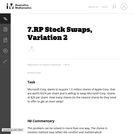
This problem can be solved in more than one way. The choice in solution method may reflect the comfort and mathematical sophistication of the student.

This is a multi-step problem since it requires more than two steps no matter how it is solved. The problem is not scaffolded for the student, but each step is straightforward and should follow from the previous with a careful reading of the problem.
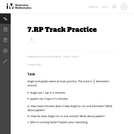
Parts (a) and (b) of the task ask students to find the unit rates that one can compute in this context. Part (b) does not specify whether the units should be laps or km, so answers can be expressed using either one.

There is a 40% chance that the lower ⅓ of the of the Cascadia subduction zone will rupture in the next 50 years, generating a large earthquake and ensuing tsunami. In this project, students will work collaboratively to design and test a model of a vertical evacuation structure. They will evaluate the performance of their models and propose further modifications to improve their design. Students will then make a scale drawing and a model to apply math concepts of scale to designing and creating an ideal model of a vertical evacuation structure. Finally, students will present their findings and proposed final design to their peers and an adult audience. The entire process takes about 2 weeks, and was expanded to include more information and activities with earthquake/tsunami prediction and application of scale. The unit is a great fit for standards within Earth Science (specifically plate tectonics and human mitigation) as well as Engineering and Design standards.
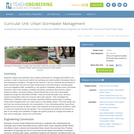
Engineers design and implement many creative techniques for managing stormwater at its sources in order to improve and restore the hydrology and water quality of developed sites to pre-development conditions. Through the two lessons in this unit, students are introduced to green infrastructure (GI) and low-impact development (LID) technologies, including green roofs and vegetative walls, bioretention or rain gardens, bioswales, planter boxes, permeable pavement, urban tree canopies, rainwater harvesting, downspout disconnection, green streets and alleys, and green parking. Student teams take on the role of stormwater engineers through five associated activities. They first model the water cycle, and then measure transpiration rates and compare native plant species. They investigate the differences in infiltration rates and storage capacities between several types of planting media before designing their own media mixes to meet design criteria. Then they design and test their own pervious pavement mix combinations. In the culminating activity, teams bring together all the concepts as well as many of the materials from the previous activities in order to create and install personal rain gardens. The unit prepares the students and teachers to take on the design and installation of bigger rain garden projects to manage stormwater at their school campuses, homes and communities.

Through relevant videos, connections to young adult literature, and hands-on exploration, students are introduced to the challenge of providing clean water and sanitation through a global lens.Additionally, students go on a “water walk” to experience the challenges that some people face each day as they locate and collect clean water.The goal of the unit is to ground the activities in a culture of empathy. Furthermore, students participate in an engineering design challenge in which they build a water filter that is both cost-efficient and effective in changing the pH and turbidity of the water samples.Finally, students have the opportunity to share their learning with peers and local experts through a sales presentation as they pitch their device and findings.Standards:CCSS English Language Arts (Grade 7)CCSS Math (Grade 7)Ohio Standards for Science (Grade 7)

Students reinforce an antenna tower made from foam insulation so that it can withstand a 480 N-cm bending moment (torque) and a 280 N-cm twisting moment (torque) with minimal deflection. During one class period, students discuss the problem, run the initial bending and torsion tests and graph the results. During the following class periods, students design, construct and test sturdier towers, and graph the results.

سيقوم الطلاب بتحليل النسب وسيستخدمون النسب لحل المسائل بواسطة نشاط تعاوني وحركي والذي فيه سينشئون "نسبًا بشرية". سيطبق الطلاب المنطق النسبي لتمثيل تطبيق حالة تضاعفية باستخدام الضرب التبادلي لحل النسب.